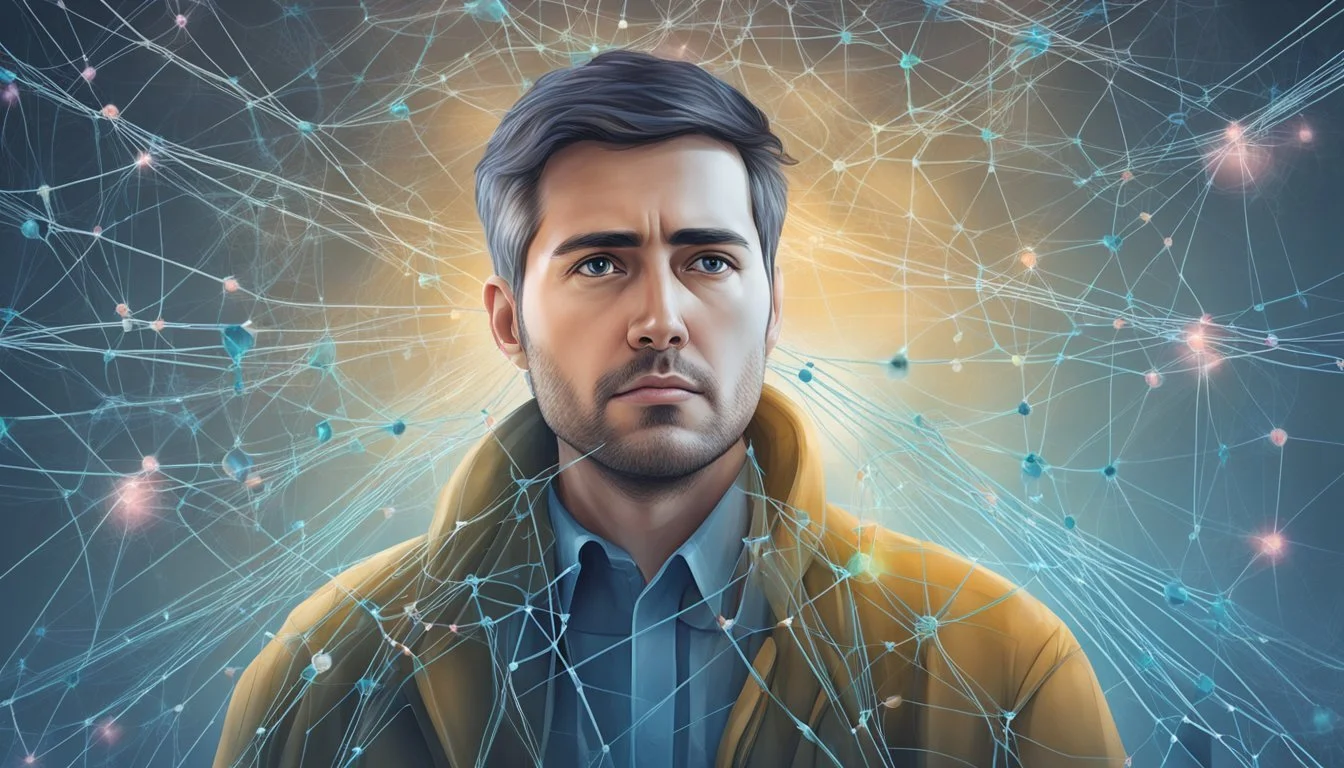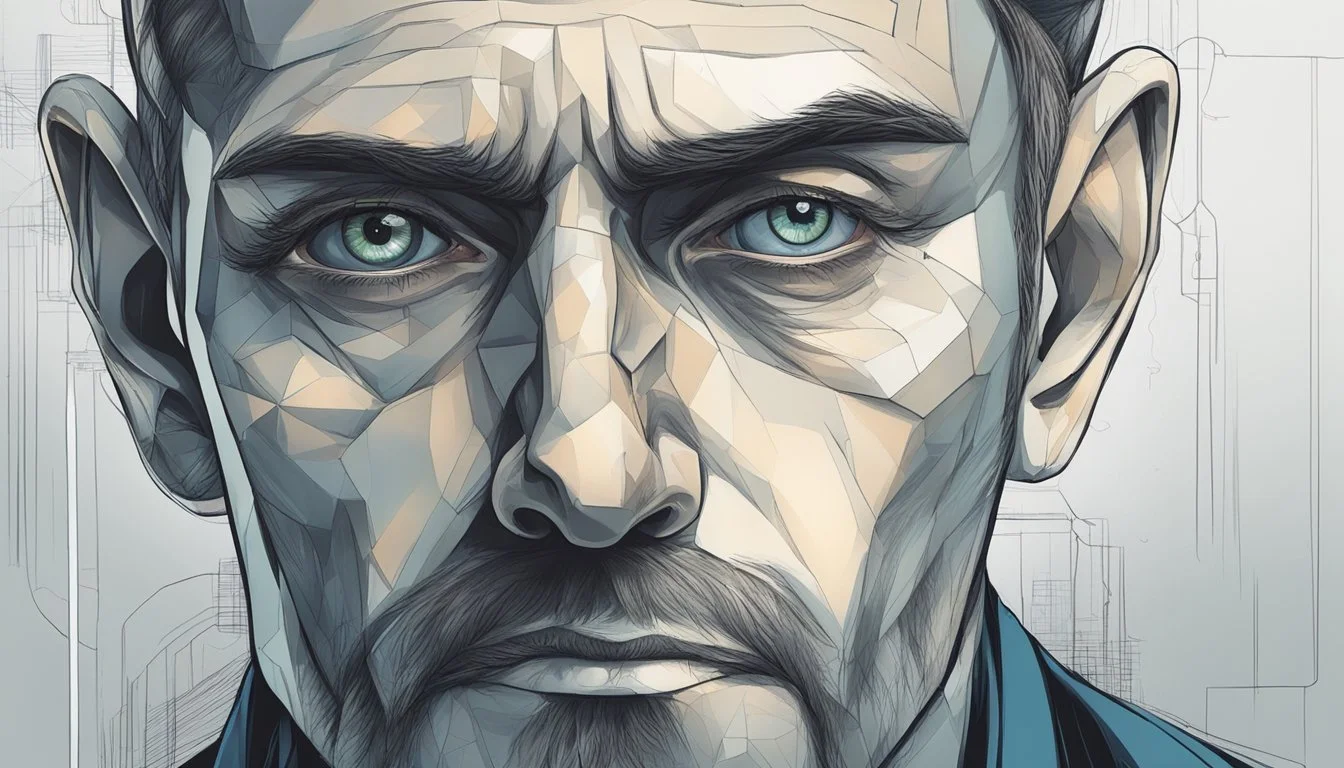Understanding the Sociopath Gaze Phenomenon
The sociopath gaze, often referred to as the "psychopathic stare," is a distinctive eye behavior associated with individuals exhibiting sociopathic or psychopathic traits. This intense, unblinking stare can be unsettling and is characterized by a lack of emotional expression in the eyes, often described as "dead" or "black."
Sociopaths and psychopaths may use this gaze as a means of domination or manipulation. It's believed to stem from their difficulty in processing emotions and their tendency to view others as objects rather than people. While not all individuals who display this type of eye contact are sociopaths, it can be a potential warning sign when combined with other behavioral traits.
Researchers have identified certain eye behaviors more common in psychopaths, including pupil dilation in response to upsetting stimuli. Non-verbal cues like the sociopath gaze can provide valuable insights into an individual's personality and potential psychopathic characteristics. Understanding these subtle signs may help people recognize and navigate interactions with those who exhibit sociopathic tendencies.
Defining Sociopathy and Psychopathy
Sociopathy and psychopathy are complex behavioral patterns characterized by a disregard for social norms and lack of empathy. These terms, while often used interchangeably, have distinct features and diagnostic criteria within the field of mental health.
Characteristics of Sociopathy and Psychopathy
Sociopaths typically display impulsive behavior and struggle with forming emotional connections. They may experience shallow emotions and show little remorse for their actions. Psychopaths, on the other hand, exhibit calculated behavior and can be highly manipulative. They often appear charming and charismatic on the surface.
Both sociopaths and psychopaths share traits such as:
Lack of empathy
Disregard for societal rules
Difficulty maintaining relationships
Tendency to engage in risky or criminal behavior
Psychopaths are generally considered more dangerous due to their ability to plan and execute harmful acts without emotional interference.
Clinical Diagnosis and Assessment Tools
Mental health professionals diagnose these conditions under the umbrella of Antisocial Personality Disorder (ASPD) using the DSM-5 criteria. The Hare Psychopathy Checklist-Revised (PCL-R) is a widely used assessment tool for identifying psychopathic traits.
Key components of the PCL-R include:
Interpersonal factors (e.g., superficial charm, pathological lying)
Affective factors (e.g., lack of remorse, shallow affect)
Lifestyle factors (e.g., need for stimulation, impulsivity)
Antisocial factors (e.g., poor behavioral controls, criminal versatility)
Healthcare providers use structured interviews and behavioral observations to evaluate an individual's score on the PCL-R. A high score may indicate the presence of psychopathic traits, but it's not a standalone diagnostic tool for ASPD.
The Sociopathic Gaze and Its Characteristics
The sociopathic gaze is a distinct visual behavior associated with individuals exhibiting sociopathic traits. This gaze pattern often reflects underlying emotional processing deficits and can serve as a tool for manipulation or intimidation.
Eye Contact and Gaze Patterns
Sociopaths typically display intense, prolonged eye contact that can be unsettling to others. Their gaze often appears fixed and unblinking, with less frequent blinking compared to the average person. This stare may seem empty or devoid of warmth, giving the impression of looking through rather than at someone.
The eyes of a sociopath might appear wider than normal, with more of the white visible. This can contribute to the unnerving quality of their gaze. Pupil dilation may also be observed, particularly in situations where the sociopath feels excitement or anticipation.
Some sociopaths may exhibit a "nearsighted" stare, characterized by a slightly unfocused quality. This could be related to reduced blood flow in the eye area.
Emotional Processing and Response
The sociopathic gaze often reflects a fundamental lack of empathy and emotional detachment. Individuals with sociopathic traits typically struggle to process and respond to emotional cues in others. This deficit may be linked to amygdala dysfunction, a brain region crucial for emotional processing.
When confronted with emotional situations, a sociopath's eyes may not convey appropriate responses. They might maintain a cold, blank expression even in circumstances that would typically elicit strong emotional reactions in others.
This emotional disconnect can manifest as a failure to mirror others' expressions or show genuine concern. The sociopath's eyes may not "smile" even when their mouth does, creating a disconcerting mismatch.
Predatory Nature and Intimidation
The sociopathic gaze can take on a predatory quality, often described as calculating or threatening. This intense stare may be used as a tool for dominance, intimidation, or manipulation. Sociopaths may deliberately employ their gaze to instill fear or discomfort in others.
In social interactions, the sociopath's eyes might dart around, assessing potential targets or opportunities for exploitation. Their gaze can shift rapidly between intense focus and casual disinterest, depending on their immediate goals.
Some individuals report feeling a sense of danger or unease when subjected to a sociopath's stare. This reaction may be an instinctive response to the lack of normal emotional cues and the perceived threat of manipulation or harm.
Social and Interpersonal Dynamics
The sociopath's gaze plays a crucial role in shaping social interactions and relationships. It serves as a powerful tool for manipulation, control, and influence.
Manipulation and Control Strategies
Sociopaths use their gaze strategically to exert control over others. They maintain intense eye contact to intimidate or create a false sense of intimacy. This prolonged eye contact can make others feel uncomfortable or vulnerable.
Sociopaths may also use their gaze to feign interest or empathy. They mimic appropriate eye movements to appear engaged in conversations. This helps them gather information for later manipulation.
Another tactic involves avoiding eye contact when lying or deflecting blame. This allows them to maintain composure and avoid detection.
Impact on Relationships
The sociopath's gaze significantly affects their interpersonal connections. Their piercing stare can initially attract potential partners or friends, creating an illusion of deep connection.
Over time, the intensity of their gaze may become unsettling. Partners often report feeling constantly watched or judged. This contributes to emotional distress and instability in relationships.
The sociopath's inability to convey genuine emotion through their eyes leads to shallow connections. Their partners may feel a persistent sense of emptiness or disconnection.
Influence and Persuasion Techniques
Sociopaths employ their gaze as a persuasion tool. They use direct eye contact to appear confident and trustworthy during negotiations or sales pitches.
They may alternate between intense stares and strategic eye movements to manipulate conversations. This helps them guide discussions in their preferred direction.
Sociopaths also use their gaze to read others' reactions. They closely observe micro-expressions and eye movements to gauge emotional responses. This information allows them to adjust their tactics for maximum influence.
Behavioral and Affective Components
The sociopathic gaze reflects underlying behavioral and emotional patterns characteristic of antisocial personality disorder. These patterns manifest in emotional detachment, aggressive tendencies, and distinct physical cues.
Emotional Detachment and Affective Responses
Individuals with sociopathic traits often display a marked lack of emotional depth. They struggle to form genuine emotional connections and may exhibit shallow affect. This emotional detachment can be observed in their eyes, which may appear cold or empty.
Sociopaths typically show reduced fear responses and diminished sensitivity to pain. Their emotional reactions to situations that would normally elicit strong feelings in others may be muted or absent. This can result in an unsettling calmness during tense or distressing situations.
Research suggests sociopaths may experience emotions differently. While they can mimic appropriate emotional responses, their internal experiences often lack the intensity or nuance of typical emotional reactions.
Aggression and Antisocial Behaviors
Sociopathic individuals frequently display aggressive and antisocial behaviors. Their gaze may convey hostility, dominance, or a predatory quality. This can contribute to feelings of unease in those around them.
Impulsivity is a common trait, leading to rash decisions and risky behaviors. Sociopaths often show a disregard for the rights and well-being of others. This may manifest in criminal activities or manipulative actions.
Their behavioral patterns can include:
Frequent lying or deception
Lack of remorse for harmful actions
Violation of social norms and laws
Exploitation of others for personal gain
These behaviors are often accompanied by a confident, even charismatic demeanor that can mask underlying antisocial tendencies.
Facial Expressions and Physical Cues
The sociopathic gaze is characterized by several distinct physical cues. These individuals may maintain prolonged eye contact that feels intense or uncomfortable. Their blinking rate is often reduced, contributing to an unnerving stare.
Facial expressions of sociopaths can be subtle or exaggerated, depending on the situation. They may display:
Dilated pupils
Limited range of genuine emotional expressions
Incongruent facial expressions (e.g., smiling during inappropriate moments)
Sociopaths may struggle to produce authentic smiles or laughter. Their expressions can appear forced or insincere. In moments of boredom or irritation, their faces may quickly shift to a flat or contemptuous expression.
The startle response in sociopaths is often diminished. They may show less physical reaction to sudden stimuli compared to others. This reduced physiological arousal can contribute to their calm demeanor in stressful situations.
Biological and Neurological Considerations
The sociopath gaze is influenced by distinct brain structures and cognitive processes. These biological and neurological factors contribute to the unique eye contact patterns and emotional responses observed in individuals with antisocial traits.
Brain Structures and Dysfunctions
The amygdala plays a crucial role in the sociopath gaze. This almond-shaped structure in the brain's temporal lobe is responsible for processing emotions, particularly fear and threat detection. In individuals with psychopathic traits, the amygdala often shows reduced activity and volume.
This dysfunction can lead to:
Decreased emotional responsiveness
Impaired fear recognition
Difficulties in processing social cues
The prefrontal cortex, which regulates decision-making and impulse control, may also exhibit abnormalities in sociopaths. These structural differences can contribute to their atypical gaze patterns and reduced empathy.
Cognitive Processes and Aberrations
Sociopaths display distinct cognitive processes that affect their gaze and social interactions. Their attention patterns often prioritize goal-relevant information while disregarding emotional cues.
Key cognitive aberrations include:
Reduced emotional resonance
Impaired fear conditioning
Enhanced focus on reward-related stimuli
These cognitive differences can manifest in the sociopath's gaze through:
Prolonged eye contact without typical signs of discomfort
Lack of pupil dilation in response to fearful stimuli
Reduced blink rate during confrontational situations
Neuroimaging studies have revealed altered connectivity between brain regions responsible for emotional processing and decision-making in individuals with psychopathic traits. This may explain their ability to maintain intense eye contact without experiencing the usual social anxiety or emotional responses.
Cultural and Ethical Implications
The sociopath gaze raises complex cultural and ethical questions. It intersects with public perceptions, treatment approaches, and broader societal attitudes toward mental health and antisocial behaviors.
Sociopathy in the Public Perception
Media portrayals often sensationalize the sociopath gaze, depicting it as cold and predatory. This reinforces stereotypes and stigma. In reality, sociopathy exists on a spectrum. Not all individuals with antisocial traits exhibit the same gaze patterns.
Cultural differences impact interpretations of eye contact. Western cultures tend to value direct eye contact. Eastern cultures may view it as confrontational. This complicates cross-cultural assessments of sociopathic behaviors.
Public fascination with sociopathy has grown. True crime media fuels misconceptions. It's crucial to separate fact from fiction when discussing sociopathic traits.
Ethical Considerations and Treatment
Mental health professionals face ethical dilemmas when treating individuals with sociopathic tendencies. Building trust is challenging. Patients may use manipulation tactics, complicating the therapeutic relationship.
Treatment aims to reduce harmful behaviors, not "cure" sociopathy. Ethical debates arise over forced treatment. Some argue it's necessary for public safety. Others see it as a violation of personal autonomy.
Healthcare providers must balance patient confidentiality with potential risks to others. This creates ethical tensions, especially in cases involving violent tendencies.
Lack of empathy in sociopaths raises questions about moral responsibility. The degree to which sociopaths can feel remorse or change remains debated among experts.
Differential Diagnoses and Comorbidities
Accurately identifying sociopathic traits requires careful consideration of other mental health conditions and potential co-occurring disorders. Proper diagnosis is crucial for effective treatment and management.
Distinguishing from Other Mental Disorders
Sociopathic behaviors can resemble symptoms of other conditions. Autism spectrum disorder (ASD) may present with social difficulties that appear similar to sociopathic traits. However, individuals with ASD typically struggle with social cues due to differences in processing, not a lack of empathy.
Narcissistic personality disorder shares some features with sociopathy, such as grandiosity and lack of empathy. The key difference lies in the narcissist's need for admiration and fragile self-esteem, which sociopaths generally lack.
Attention-deficit/hyperactivity disorder (ADHD) can manifest as impulsivity and disregard for rules, mimicking sociopathic behavior. Unlike sociopathy, ADHD does not involve intentional manipulation or lack of remorse.
Identifying Comorbid Conditions
Sociopathy, or antisocial personality disorder (ASPD), often co-occurs with other mental health issues. Substance use disorders are common comorbidities, as individuals may use drugs or alcohol to manage emotions or engage in risky behaviors.
Anxiety disorders can coexist with sociopathy, though they may be less readily apparent due to the individual's tendency to mask vulnerabilities. Depression is another potential comorbidity, particularly in cases where sociopathic behaviors lead to social isolation or legal troubles.
Borderline personality disorder may overlap with sociopathic traits, sharing features like impulsivity and unstable relationships. Careful assessment is needed to differentiate or identify the presence of both conditions.
Real-life Applications and Case Studies
Sociopath gaze manifests in various real-world situations, from personal relationships to criminal behavior. Understanding its implications is crucial for developing effective strategies to handle sociopaths and ensure public safety.
Handling Sociopaths in Personal Relationships
Recognizing sociopathic gaze patterns can help individuals protect themselves in personal relationships. Sociopaths often use intense eye contact to manipulate and control others. They may stare fixedly or avoid eye contact altogether, depending on their goals.
Key strategies for handling sociopaths:
Maintain emotional distance
Set firm boundaries
Avoid sharing personal information
Seek support from trusted friends and family
Document concerning behavior
Relationships with sociopaths can be challenging and potentially dangerous. Professional help from therapists specializing in personality disorders is often necessary for those involved with sociopaths.
Notable Cases and Criminal Behavior
Several high-profile criminal cases have involved sociopaths known for their distinctive gaze patterns. Ted Bundy, a notorious serial killer, was described as having piercing, hypnotic eyes that he used to charm victims.
Case study: Jeffrey Dahmer
Known for his vacant, emotionless stare
Used his gaze to lure victims
Expressed lack of empathy through eye contact during trial
Law enforcement agencies now train officers to recognize sociopathic gaze patterns as potential indicators of criminal behavior. This knowledge aids in interrogations and investigations.
Preventive Strategies and Public Safety
Understanding sociopath gaze contributes to developing preventive strategies and enhancing public safety. Schools and workplaces increasingly incorporate awareness training to help identify potential sociopaths.
Public safety measures:
Education programs on recognizing sociopathic behavior
Improved screening processes in high-risk professions
Enhanced security protocols in vulnerable environments
Mental health professionals emphasize the importance of early intervention. Identifying sociopathic tendencies in children and adolescents can lead to more effective treatment and reduce the risk of antisocial behavior in adulthood.
Legal systems worldwide are adapting to address the challenges posed by sociopaths. Some jurisdictions now consider sociopathic traits in sentencing and rehabilitation programs.
The Sociopath Gaze in Media and Literature
The sociopath gaze has become a recognizable trope in popular media and literature. It often serves as a visual cue to indicate a character's lack of empathy or manipulative nature.
Portrayals in Film and Television
The sociopath gaze is frequently depicted in films and TV shows as a cold, penetrating stare. Characters like Hannibal Lecter in "The Silence of the Lambs" exemplify this trope with their unblinking, predatory gaze.
In the series "Dexter," the titular character's eyes often convey a detached curiosity when observing others. This reinforces his sociopathic tendencies.
Some productions use camera techniques to emphasize the sociopath gaze. Close-ups on unmoving eyes or lingering shots of a character's face can create an unsettling effect.
While these portrayals can be dramatic, they may perpetuate stereotypes about sociopathy. Not all individuals with antisocial personality disorder exhibit such obvious visual cues.
Literary Examples and Analysis
In literature, authors often describe the sociopath gaze to reveal a character's inner nature. Vladimir Nabokov's "Lolita" features Humbert Humbert, whose gaze is described as both alluring and predatory.
Patricia Highsmith's Tom Ripley, from "The Talented Mr. Ripley," is noted for his ability to mimic emotions with his eyes while feeling nothing inside. This contrast highlights his sociopathic traits.
Literary analysis of the sociopath gaze often focuses on:
Descriptive language used to convey emptiness or coldness
Contrasts between outward appearance and inner thoughts
Character reactions to the sociopath's gaze
These portrayals in literature provide deeper insights into sociopathic characters beyond visual cues alone.
Conclusion
The sociopath gaze remains a complex and intriguing aspect of sociopathic behavior. This intense stare can serve as a manipulation tactic, allowing sociopaths to exert control over others.
Recognizing the sociopath gaze may help in identifying potentially harmful individuals. However, it's crucial to consider other behavioral patterns and not rely solely on this single characteristic.
Future research could explore the neurological basis of the sociopath gaze and its prevalence across different cultures. Such studies may provide valuable insights into the underlying mechanisms of sociopathic behavior.
Increased awareness about the sociopath gaze and other sociopathic traits can empower individuals to protect themselves from manipulation. Education and professional guidance are key in developing this awareness.
While the sociopath gaze is a notable feature, it's important to approach the topic with caution and avoid stigmatizing individuals based on appearance alone. A comprehensive understanding of sociopathy requires consideration of multiple factors beyond just visual cues.









